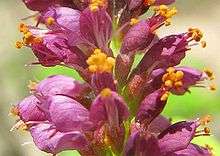Amorpha fruticosa
Amorpha fruticosa is a species of flowering plant in the legume family (Fabaceae) known by several common names, including desert false indigo, false indigo-bush, and bastard indigobush. It is found wild in most of the contiguous United States, southeastern Canada, and northern Mexico, but it is probably naturalized in the northeastern and northwestern portion of its current range. The species is also present as an introduced species in Europe,[1] Asia, and other continents. It is often cultivated as an ornamental plant, and some wild populations may be descended from garden escapes.

| Amorpha fruticosa | |
|---|---|
| Scientific classification | |
| Kingdom: | |
| (unranked): | |
| (unranked): | |
| (unranked): | |
| Order: | |
| Family: | |
| Subfamily: | |
| Genus: | |
| Species: | A. fruticosa |
| Binomial name | |
| Amorpha fruticosa | |
| Synonyms | |
| |
A. fruticosa grows as a glandular, thornless shrub which can reach 5 or 6 m (16 or 20 ft) in height and spread to twice that in width. It is somewhat variable in morphology. The leaves are made up of many hairy, oval-shaped, spine-tipped leaflets. The inflorescence is a spike-shaped raceme of many flowers, each with a single purple petal and ten protruding stamens with yellow anthers. The fruit is a legume pod containing one or two seeds.
6'-O-β-D-glucopyranosyl-12a-hydroxydalpanol, a rotenoid, can be found in the fruits of A. fruticosa.[2] Several members of the amorfrutin class of compounds have been isolated from the fruits.[3] Amorfrutins as well as other secondary metabolites from A. fruticosa have displayed favorable bioactivities counteracting diabetes and the metabolic syndrome.[4]
It is a larval host to the clouded sulphur, gray hairstreak, hoary edge, Io moth, marine blue, silver-spotted skipper, and southern dogface.[5]
Cultivars
- 'Albiflora', with white flowers.
- 'Crispa', with curled leaves.
- 'Lewisii', with narrow leaves.
- 'Pendula', with arching branches, forming a dome shape.
References
- DAISIE (2009). Handbook of Alien Species in Europe. Dordrecht: Springer. p. 399. ISBN 978-1-4020-8279-5.
- Hak Ju Lee, Ha Young Kang, Cheol Hee Kim, Hyo Sung Kim, Min Chul Kwon, Sang Moo Kim, Il Shik Shin and Hyeon Yong Lee (2007). "Effect of new rotenoid glycoside from the fruits of Amorpha fruticosa LINNE on the growth of human immune cells". Cytotechnology. 52 (3): 219–226. doi:10.1007/s10616-006-9040-5. PMC 3449409. PMID 19002880.CS1 maint: uses authors parameter (link)
- Weidner, C.; De Groot, J. C.; Prasad, A.; Freiwald, A.; Quedenau, C.; Kliem, M.; Witzke, A.; Kodelja, V.; Han, C.-T.; Giegold, S.; Baumann, M.; Klebl, B.; Siems, K.; Muller-Kuhrt, L.; Schurmann, A.; Schuler, R.; Pfeiffer, A. F. H.; Schroeder, F. C.; Bussow, K.; Sauer, S. (2012). "Amorfrutins are potent antidiabetic dietary natural products" (PDF). Proceedings of the National Academy of Sciences. 109 (19): 7257. Bibcode:2012PNAS..109.7257W. doi:10.1073/pnas.1116971109. PMC 3358853. PMID 22509006.
- Kozuharova E, Matkowski A, Woźniak D, Simeonova R, Naychov Z, Malainer C, Mocan A, Nabavi SM, Atanasov AG (June 8, 2017). "Amorpha fruticosa - A Noxious Invasive Alien Plant in Europe or a Medicinal Plant against Metabolic Disease?". Frontiers in Pharmacology. 8: 333. doi:10.3389/fphar.2017.00333. PMC 5462938. PMID 28642702.CS1 maint: uses authors parameter (link)
- The Xerces Society (2016), Gardening for Butterflies: How You Can Attract and Protect Beautiful, Beneficial Insects, Timber Press.
External links
| Wikimedia Commons has media related to Amorpha fruticosa. |
- Jepson Manual Treatment
- USDA Plants Profile
- "Amorpha fruticosa". Germplasm Resources Information Network (GRIN). Agricultural Research Service (ARS), United States Department of Agriculture (USDA).
- Amorpha fruticosa L. Medicinal Plant Images Database (School of Chinese Medicine, Hong Kong Baptist University) (in Chinese) (in English)